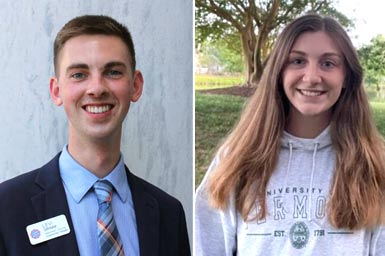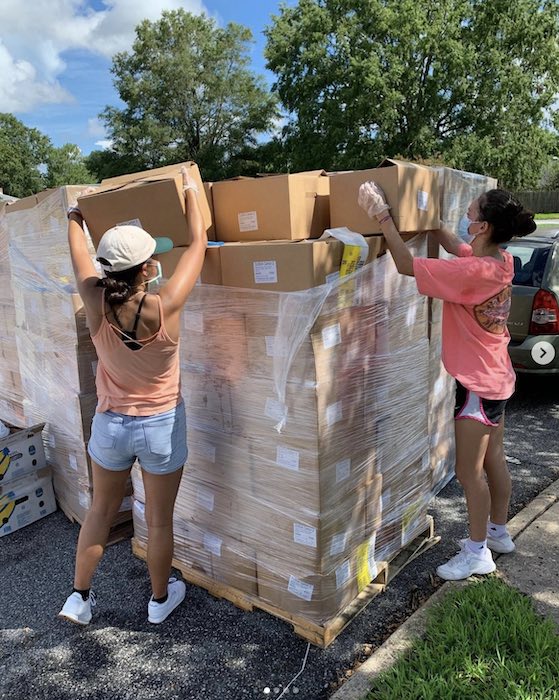Meet Our Youngest Site Directors

This month we are highlighting the work of two young leaders in our Food Rescue US network – both of whom were still in high school when they got their start. Levi is a rising college junior and the Executive Director of JEE Foods, a Food Rescue US licensee. Natalia just graduated high school this month and is the Co-Site Director of Food Rescue US Virginia Beach. We sat down with them recently to ask about their experience.
What first sparked your interest in food rescue work?
Levi: I first became involved in food rescue back in 2018 for a school project. Our school group was working with the United Nations on a global partnership with a school in South Korea where our task was to come up with solutions to end poverty and hunger. While looking at these global issues, we noticed similarities in our own community. The lack of jobs, unstable economy, and a lack of education all bubble into it. But it all starts with food. To break the cycle of poverty through education and job training, people first need a stable source of food.
Natalia: My story starts with a school project, too. In my freshman year, I had to find an issue in my community that I wanted to address. One thing that I noticed is when I would go from my field hockey practice to the grocery store to get a coffee it was always seven or eight at night. And that’s the time they were throwing away all their deli food, all their pizza, all their salads, all their sandwiches, all in the trash. And just was really astounding to see. I always knew not to waste food at home, but I just didn’t realize the scale of it in grocery stores and restaurants. So that became my issue. As I was researching food waste and what people are doing to address it, I came across Food Rescue US. There was no site near me, so we worked with the national team to start one.
How did you balance such a big responsibility with school?

Levi: When we first started, we were using a spreadsheet to organize rescues. As you can imagine, that was difficult to manage during the school day. We needed a better solution, and that was the Food Rescue US app. We could be hands-off during the school day and volunteers would still know what they needed to do. It took a lot of the pressure off. At this point, we’re managing roughly 70 to 80 food rescues per week through the software, and everyone in our organization is either in high school or early college.
Natalia: It never felt like too much to handle in the early days. I was just fired up about getting Food Rescue US Virginia Beach started! Everyone is really helpful in the Food Rescue network and supportive of me as a student. The schedule is flexible, and of course I have my mom co-directing with me. We split up tasks and cover for each other if she has work or I have school. It’s the team effort that’s made it possible.
What does your operation look like now?
Levi: We serve over a hundred nonprofits today. We’re based in southwest Ohio, but we reach into the entire other side of Ohio, across Indiana and into the Appalachia Mountains in Kentucky. We started out very, very small in the rural community, and it’s just kept growing. At this point, we have probably about 70 volunteers that are doing the recurring rescues for us on that day-to-day basis. We serve drug recovery centers, veteran centers, senior centers, food pantries, food banks. We do a lot of pop-up markets as well. So we kind of serve a little bit of everybody.

Natalia: Right now, we have about 30 food donors and 190 volunteers signed up to deliver that food to around 45 recipient organizations. We’re continuing to expand here with new partnerships in the works. I’m working with the Crop Foundation that is connecting us with a local restaurant to be a hub for large food donation storage. The chef and his volunteer students will take raw produce donations and turn them into meals for distribution. We are also in touch with Support and Feed that is starting up in this area. That will be another source of prepared meals for us to distribute to receiving agencies. It’s an exciting time.
What impact are you seeing from your work?
Levi: From a pure numbers standpoint, we’ve rescued and distributed just about 7 million pounds of food at this point. But numbers don’t even begin to tell the story. I think that’s so special about this work is it’s not transactional, but very personal. We are out there talking with people and learning their stories. It’s so rewarding to understand the need and then connect the dots to get that food there.
Natalia: I agree that it’s about so much more than the numbers. When we drop off food at our receiving agencies, we get to talk with people and hear so many stories. We hear all these stories about the people we are helping and the impact we are making. You get to see firsthand that food is what connects us all.
How does the food rescue mission resonate with your generation?
Levi: Our organization is appealing because we aren’t just sitting on the sidelines of a problem. We’re giving students real opportunities and responsibilities to make changes, and then we rally around them to help figure it out. I think food rescue is so great for that because of the community that goes around it. The agencies are supporting you, the food donors are saying, thank you so much for coming, and then we’re here to make sure that our volunteers have the platform, the tools they need to succeed.
Natalia: We started during the pandemic, so volunteering with Food Rescue US to hand out USDA food boxes was a safe way for a lot of my friends and classmates to see each other and feel like they were doing something. And from there, they just kept coming back. People have different reasons. For some it’s about social justice and food insecurity. For others it’s about the environmental impact of food waste. It’s also just an easy, cool way to volunteer. Just go on your phone and click a rescue kind of like you’re doing DoorDash. It’s just so easy and it’s such an impactful way to do something in your community.
What advice do you have for other new site directors?
Levi: I think student site directors have this aspiration to become the biggest site right away, to have the most donors and be a national name. But my advice is you have to start local, recognize the community piece of it and then build those connections and opportunities around it. Maybe don’t secure a large contract with your grocery store right away. Start with the local farm stands. Start with somebody local where you can learn on a day-to-day basis with them. Get that first rescuer or that first adopter that picks up every week from you. And then learn.
Natalia: My mom and I had a lot of success with cold calling – just showing up to businesses to talk about donating their excess food. So don’t be afraid to show up but show up with something in hand like the Emerson Act or your state’s rules around food donation. The first question is always “will I be protected?” And it’s easier to have something in print to point to that says yes, you can do this safely.
Looking Ahead
This fall, Levi will enter his junior year at Miami University and continue to serve as the Executive Director of JEE Foods. This year he plans to launch a rescued food pantry on campus and take a student-renovated mobile market bus to surrounding rural communities that lack access to fresh foods. Natalia will begin her freshman year at Harvard and plans to keep helping her mom with FRUS Virginia Beach while also branching out in Boston. She aims to work with the Harvard Food Policy Law clinic and maybe even start a food rescue program on campus. We are fortunate to have these exceptional young leaders within our ranks and look forward to seeing what they do next.
